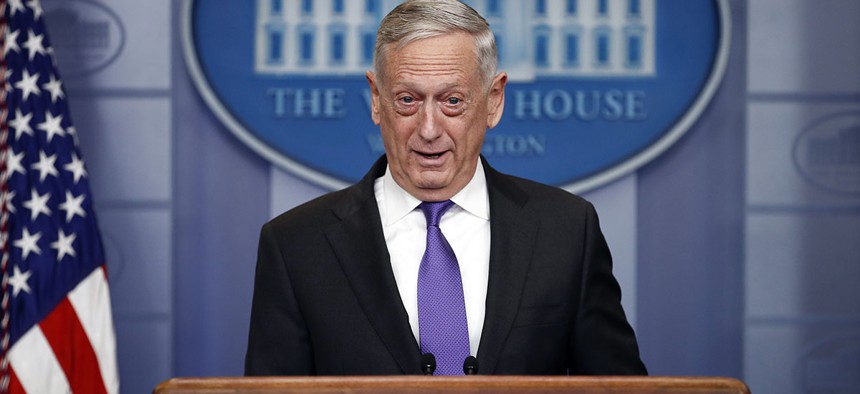How to Accelerate IT Modernization and Technology Innovation in Defense

Defense Secretary Jim Mattis Carolyn Kaster/AP
Our military needs cutting-edge technology, but warfighters often find themselves generations behind.
While the roller coaster of Congressional budget negotiations in recent months has created uncertainty in Defense Department, one thing seems to remain steady: the emphasis on improving the department’s information technology. As part of the 2018 National Defense Authorization Act, the Modernizing Government Technology Act became law late last year, just one of the signs that the federal government is putting its money where its mouth is.
As Americans, we all know how dependent upon technology our daily lives have become. However, our warfighters often find themselves generations behind when it comes to the technology they use at work. This won’t do if we’re to continue to hold our position of power: Our military needs to be using the most advanced technology available.
Two recent defense technology-focused events—the Charleston Defense Contractor Association Defense Summit and the West 2018 Conference—brought together thousands from industry, government and academia to discuss topics such as technology innovation and IT modernization. Both conferences carried an undertone of needing warfighting technology, innovation and IT acquisition to go faster. Rear Adm. Christian “Boris” Becker, commander of Space and Naval Warfare Systems Command spoke at both conferences, stating, “Our adversaries are diverse and rapidly evolving new capabilities. We need to be moving at the same speed to be able to address real-time threats” and “Strategic competition is driving the urgency for us to find our way to deliver, to modernize, to enable the joint force with a more lethal force.”
In keeping with the drive for technology innovation and IT Modernization, Defense Secretary Jim Mattis recently announced the new national defense strategy. The plans include investing in “new high-end capabilities” and emerging technologies for potential high-end warfare. He summarized his report by saying that “a rapid, iterative approach to capability development will reduce costs, technological obsolescence, and acquisition risk.” Additionally, he emphasized that the future of national security innovation must include traditional and nontraditional defense partners.
One Navy organization is taking these goals to heart and working to strengthen and expand the government and industry partnership to make things go faster. The SPAWAR Systems Center Atlantic recently announced its plans to stand up the Information Warfare Research Project, under an other transaction authority. An OTA allows the government to do work with companies outside of the traditional defense contracting base and offers a more streamlined approach to funding technology innovation. This OTA is a first for SPAWAR and will fund up to $100 million for prototype solutions in areas such as cyber warfare, cloud computing, wireless and mobile technology and data analytics, among others. Scott Heller, commanding officer of SSC Atlantic said it best, “Our industry partners give us a strategic advantage as we develop and field Information Warfare solutions. We need each other, and we need the great competition of ideas our partnership brings.”
So, what does all of this mean for businesses working in the defense contracting sector? As a nonprofit defense contractor industry association, CDCA offers a few tips below:
- Consider becoming a member of relevant industry associations such as CDCA, Armed Forces Communications and Electronics Association or National Defense Industrial Association. These organizations all have regular newsletters and other communication venues to ensure you’re getting the latest information.
- Pay attention to opportunities announced on publicly available sites such as GovWin and register for updates through an agency-specific site such as the Navy’s SeaPort-e portal and SPAWAR’s eCommerce site.
- Register for and participate in relevant industry days, technical exchanges and similar events that provide opportunities to network with potential bidding partners and government clients.
Acquisition and technology innovation continues to drive IT modernization. From the federal headquarters to the front lines, there is an opportunity for everyone to join the conversation, share best practices and shape the future with creative solutions. We should all feel challenged to maintain the momentum and keep the dialogue and ideas continually flowing towards a new tomorrow.
Heather Walker is the vice president of the Charleston Defense Contractors Association and an active board member.
NEXT STORY: How to Improve Federal Cybersecurity Efforts





